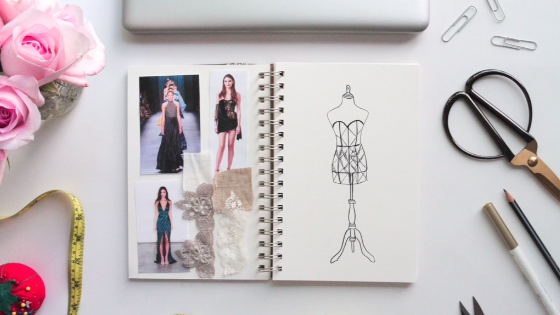When starting a clothing line, one of the most important things to do is your Market research. Often times, entrepreneurs jump in without doing this critical step. But if you skip this step the foundation in which you build your brand on will be unstable (and we don’t want that!) We want to share 6-point checklist of important things you need to know and do for Market Research before you start a clothing line.

Sure, you’re brimming with inspiration, making mood boards, sketching garments, defining your ideal customer. It’s really happening – you’re going to launch your clothing line! We’re all about the excitement, but let’s take a quick time out. Have you done your market research yet? We want to share 6 important tips with you before you start your clothing line.
What is Market Research?
Market research is a key step to ensuring your fashion brand starts out on the right foot. Rather than jumping in blindly, you want to know exactly what your ideal customer is looking for when starting a clothing line, exactly how your brand can address those needs, and what makes you stand out from competitors. When we work with our clients, one of the first things we ask them to do is conduct market research and competitor analysis. Here are the six things you need to know when doing market research for fashion brands.
Bonus tip:
Before you even begin your market research, be sure you’ve worked on your Ideal Customer Avatar so that you know your target market inside and out when starting a fashion line. If you haven’t quite gotten to that point yet (or if you just had to Google “Ideal Customer Avatar”), this toolkit is a great place to start.
Here are 6 Things you NEED to know about your market when starting a clothing line.
KNOW THE CHARACTERISTICS OF YOUR IDEAL CUSTOMER AVATAR
- Demographics: Get to know the demographics characteristics of your ideal customer when starting your clothing line. What age and gender are they? Do they have a specific income range or occupation? Even geographic location can make a difference: think about the customers of a swimsuit line vs an outerwear line. Get as specific as possible.
KNOW YOUR CUSTOMERS’ BUYING HABITS AND PERSONALITY
- Lifestyle and personality: Go beyond basic demographics and think about your target customers’ buying habits and personality. Where do they shop and how often? Do they like to try on in stores or are they comfortable buying online? Are they a business person, a socialite, a frequent traveller?
List a few of their values and hobbies. Shop the stores you want to sell in. And remember – your ideal customer probably isn’t you, so it can be helpful to talk through your ideas with friends and mentors. Chances are, someone in your network fits into your target demographic or can help connect you with someone who does, and you can ask them questions to help validate your concepts and assumptions.
CREATE YOUR UNIQUE SELLING POINT OR UNIQUE SELLING PROPOSITION (USP)
- Benefits: No matter how beautiful your line is, if you don’t have a unique selling proposition, it’ll be impossible to build a story around why people need your designs. Start by thinking about the features of your product, then think about why each feature matters to your ideal customer avatar. For example, a feature might be organic materials or special wicking fabric, but the benefit might be that it’s safer for their kids, more comfortable, or that it holds up in the wash. It can be helpful to ask yourself, “Why should they care?” to clarify your benefits.
Perhaps most importantly, remember that it’s about so much more than the physical features of your fashion line – it’s about how people respond emotionally to your products and branding, it is an experience. You might think you’re selling an outfit, but to the customer, you’re selling a persona, a sense of confidence, comfort, peace of mind. People portray who they are, what they value, or what they want to be through what they wear. Find your niche, offer facts, fantasies, and reasons to backup your claims, and build your story around it.
KNOW WHAT IS HAPPENING IN YOUR CUSTOMERS’ WORLD
- Influential Factors: Research the factors influencing market trends. This might include economic factors, seasonality, technology, or sociocultural trends. What are people talking about and how can your brand fit into the conversation? Knowing these factors is key to relaying your brand’s value to buyers.
KNOW YOUR COMPETITION
- Competitive Analysis: Know your competition thoroughly. Understand their product line, aesthetic, pricing, where they sell, who they sell to, and what their market share is. Even if there doesn’t seem to be a competitor offering exactly what you are, it’s important to know what alternatives exist for potential customers so that you can carve out a unique niche in the market. We have a workbook created to help you research your competitors.
CREATE YOUR ELEVATOR PITCH
- Positioning Statement or Elevator Pitch: All of this analysis and research should provide you with a clear vision of your customers and competitors. A positioning statement is a great way to sum up what you’ve learned and present it succinctly. A great positioning statement includes who your ideal customer is, what challenge or need your line addresses, and what differentiators or benefits back up your claims.
WHAT TO DO NEXT
Feeling overwhelmed by all of this? Don’t worry! We’ve put together a helpful form that will walk you through the most important market research questions and provide a structure to organize your findings and positioning statement. Download the free Market Research Form below! 👇🏼👇🏼 And if you need more help, right now, you can apply for free consultation (spots are limited) or snag a Strategy Session.
Good luck friends!

